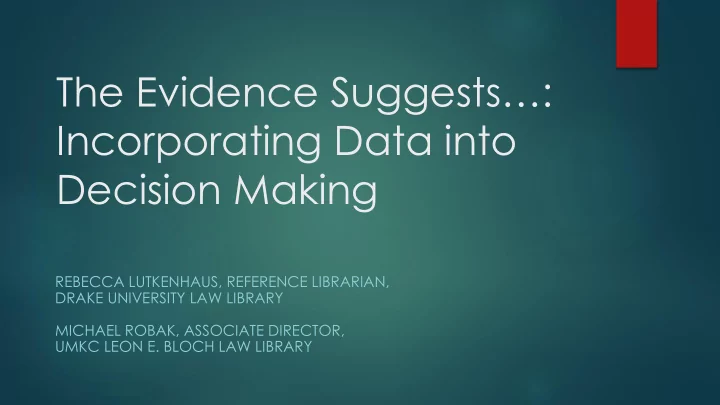

The Evidence S uggests…: Incorporating Data into Decision Making REBECCA LUTKENHAUS, REFERENCE LIBRARIAN, DRAKE UNIVERSITY LAW LIBRARY MICHAEL ROBAK, ASSOCIATE DIRECTOR, UMKC LEON E. BLOCH LAW LIBRARY
Where to begin Evidence Based Practice “is an interdisciplinary approach to clinical practice that has been gaining ground following its formal introduction in 1992.” From: http://en.wikipedia.org/wiki/Evidence- based_practice It started in medicine as evidence-based medicine (EBM) and spread to other fields such as… Library and Information Science
Additional background “Most practices in evidence -based policy are based on those arising from evidence- based medicine.” “In this parent discipline, evidence an data are (and absolutely must be) distinguished from one another” “This is because EBM proponents claim that only evidence (and not, say, data) must be used to ground healthcare decisions. And, fortunately for them, in their domain of practice, a very simple distinction is used and accepted.”
Starting point What is the difference between Evidence Statistics Data FROM Evidence Based Medicine “ Information about individuals is data. But once aggregated via appropriate statistical work, and reported as the result of a trial, it is evidence. Put another way, a defining character of evidence in EBM is that it is compiled from many individuals. So data is token, evidence type .”
The Hierarchy of Evidence Based Practice (EBP) Underlying Data Application of Statistics Evidence Policy
Why data matters o Leads to better decisions o Results in continuous improvement o Confirms accountability requirements have been met o Conveys the library’s value to the organization o Prioritizes competing demands o Focuses effort on the most important functions o Need to maximize decreasing budgets o Increasing emphasis on the business aspect of legal practice
Evidence-based librarianship “Promotes the collection, interpretation, and integration of valid, important and applicable user- reported, librarian-observed, and research-derived evidence .” Andrew Booth, From EBM to EBL: Two Steps Forward or One Step Back?, M ED . R EFERENCE S ERVICES Q., Fall 2002
How EBL works Develop a focused, answerable question P = population or problem P = among 2L and 3L students I = intervention writing a seminar paper C = comparison (if I = does research training from a necessary) librarian O = outcome C = versus no training O = affect the quality of the references used in the paper? Prediction, intervention, exploration
How EBL works Levels of evidence Systematic reviews Meta-analysis Cohort studies Surveys Case studies
Types of data Quantitative – measurement tick marks on a sheet Qualitative – meaning READ scale
Evaluation plan to gather data Decide what you are evaluating (see table) Identify stakeholders Determine timeline Select performance indicators (SMART) P ETER B ROPHY , M EASURING L IBRARY P ERFORMANCE : P RINCIPLES AND T ECHNIQUES (2006) Select methods and instruments
What methods (e.g. surveys, focus groups) do you use to gather and analyze data?
What software/tools do you use to gather and analyze data?
LibAnalytics DRAKE UNIVERSITY
Gimlet UNIVERSITY OF MISSOURI – KANSAS CITY
What trends have you noticed in analyzing your data?
Visualization o Summarize findings in less than a page o Focus on your key message o Identify audiences, and the key audience o Quantitative data: tables, charts, histograms o Qualitative data: explain process used to interpret data
How are you conveying your value and persuading stakeholders with your data?
Recommend
More recommend